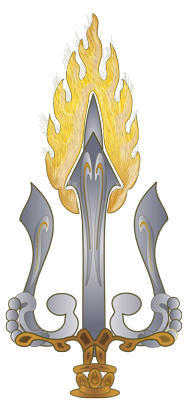Khatvanga
Khatvāṅga (Sanskrit:खट्वाङ्ग) is a long, club-like instrument originally created to be used as a weapon. It is a divine weapon of various significance in Dharmic Traditions such as Shaivism and Esoteric Buddhism. The Khatvanga was adopted by some lineages of historical Tantra though it preceded such traditions. khatvanga: Ritual staff carried by certain tantric masters adorned with various symbols of tantric practice. For example, Guru Padmasambhava, Yeshe Tsogyel, and Vajravarahi are all depicted carrying a khatvanga.
History
In the Hindu History, Lord Shiva as well as Lord Rudra carried the Khatwang as a staff. The Khatwang has a great significance in the Shaiva pantheon. Lord Shiva as well as Rudra are called the ‘Khatwangi’ for bearing this club.
Beer (2003: p. 102) relates how the symbolism of the khatvanga that entered esoteric Buddhism (particularly from Padmasambhava) was a direct borrowing from the Shaivite Kapalikas who frequented places of austerity such as charnel grounds and cross roads etcetera as a form of 'left-handed path' (Sanskrit: vamamarga) 'spiritual practice' (Sanskrit: sadhana)::
- "The form of the Buddhist khatvanga derived from the emblematic staff of the early Indian Shaivite yogins, known as kapalikas or 'skull-bearers'. The kapalikas were originally miscreants who had been sentenced to a twelve-year term of penance for the crime of inadvertently killing a Brahmin. The penitent was prescribed to dwell in a forest hut, at a desolate crossroads, in a charnel ground, or under a tree; to live by begging; to practice
austerities; and to wear a loin-cloth of hemp, dog, or donkey-skin. They also had to carry the emblems of a human skull as an alms-bowl, and the skull of the Brahmin they had slain mounted upon a wooden staff as a banner.These Hindu kapalika ascetics soon evolved into an extreme outcaste sect of the 'left-hand' tantric path
(Skt. vamamarg) of shakti or goddess worship. The early Buddhist tantric yogins and yoginis adopted the same goddess or dakini attributes of the kapalikas. These attributes consisted of; bone ornaments, an animal skin loincloth, marks of human ash, a skull-cup, damaru, flaying knife, thighbone trumpet, and the skull-topped tantric staff or khatvanga."
Khatwang (Khatwa - Cot + Anga - Part) etymologically means the part of a cot.
Originally, the Khatwangam was made of bones, especially, the long bones of forearm or the leg of human beings or animals. However, subsequently, wood and metals were used to build the weapon.
Structurally, the Khatwang is a long club with kapalas (Skull) engraved on the body. The Khatwang also acts a vajra.
Utility
The transformation of Khatwang from a weapon to religious staff took place during the Fourth Century A.D. with the advent of Buddhism. The deities as well as saints of Vajrayana Buddhism appear with this staff.
Esoteric Buddhism
In the Buddhist lore, it is also a particular divine attribute of Padmasambhava and endemic to his iconographic representation. The Khatvanga is also emblematic of Padmasambhava when depicted as an accoutrement of his divine consorts, Mandarava and Yeshe Tsogyal and according to the Twilight Language is representative of Yab-Yum in these examples.
The khatvanga, comes as a danda with three severed heads denoting liberation from the three worlds or triloka, crowned by a trishula and dressed with a sash of the Himalayan Rainbow or Five Pure Lights of the Mahabhuta.

